For at least 40,000 years before European settlement in the late 18th century, Australia was inhabited by indigenous Australians,[11] who belonged to one or more of roughly 250 language groups.[12][13] After discovery by Dutch explorers in 1606, Australia's eastern half was claimed by Britain in 1770 and initially settled through penal transportation to the colony of New South Wales, formally founded on 7 February 1788[14] (although formal possession of the land had occurred on 26 January 1788). The population grew steadily in subsequent decades; the continent was explored and an additional five self-governing Crown Colonies were established.
On 1 January 1901, the six colonies became a federation and the Commonwealth of Australia was formed. Since Federation, Australia has maintained a stable liberal democratic political system and is a Commonwealth realm. The population is 22 million, with approximately 60 per cent concentrated in and around the mainland state capitals of Sydney, Melbourne, Brisbane, Perth and Adelaide. The nation's capital city is Canberra, in the Australian Capital Territory. Approximately 56 per cent of Australia's population live in either Victoria or New South Wales, and approximately 77 per cent live on the mainland's east coast.
A prosperous developed country, Australia is the world's thirteenth largest economy. Australia ranks highly in many international comparisons of national performance such as human development, quality of life, health care, life expectancy, public education, economic freedom and the protection of civil liberties and political rights.[15] Australia is a member of the United Nations, G20, Commonwealth of Nations, ANZUS, OECD, APEC, Pacific Islands Forum and the World Trade Organization.
Contents[hide] |
Etymology
Pronounced [əˈstɹæɪljə, -liə] in Australian English,[16] the name Australia is derived from the Latin australis, meaning "southern". The country has been referred to colloquially as Oz since the early 20th century.[N 5] Aussie is a common, colloquial term for "Australian".Legends of Terra Australis Incognita—an "unknown land of the South"—date back to Roman times and were commonplace in medieval geography, although not based on any documented knowledge of the continent. Following European discovery, names for the Australian landmass were often references to the famed Terra Australis.
The earliest recorded use of the word Australia in English was in 1625 in "A note of Australia del Espíritu Santo, written by Master Hakluyt" and published by Samuel Purchas in Hakluytus Posthumus, a corruption of the original Spanish name Austrialia del Espíritu Santo for an island in Vanuatu.[21] The Dutch adjectival form Australische was used in a Dutch book in Batavia (Jakarta) in 1638, to refer to the newly discovered lands to the south.[22] Australia was later used in a 1693 translation of Les Aventures de Jacques Sadeur dans la Découverte et le Voyage de la Terre Australe, a 1676 French novel by Gabriel de Foigny, under the pen-name Jacques Sadeur.[23] Referring to the entire South Pacific region, Alexander Dalrymple used it in An Historical Collection of Voyages and Discoveries in the South Pacific Ocean in 1771. By the end of the 18th century, the name was being used to refer specifically to Australia, with the botanists George Shaw and Sir James Smith writing of "the vast island, or rather continent, of Australia, Australasia or New Holland" in their 1793 Zoology and Botany of New Holland,[24] and James Wilson including it on a 1799 chart.[25]
The name Australia was popularised by the explorer Matthew Flinders, who pushed for it to be formally adopted as early as 1804. When preparing his manuscript and charts for his 1814 A Voyage to Terra Australis, he was persuaded by his patron, Sir Joseph Banks, to use the term Terra Australis as this was the name most familiar to the public. Flinders did so, but allowed himself the footnote:
This is the only occurrence of the word Australia in that text; but in Appendix III, Robert Brown's General remarks, geographical and systematical, on the botany of Terra Australis, Brown makes use of the adjectival form Australian throughout,[27]—the first known use of that form.[28] Despite popular conception, the book was not instrumental in the adoption of the name: the name came gradually to be accepted over the following ten years.[29] Lachlan Macquarie, a Governor of New South Wales, subsequently used the word in his dispatches to England, and on 12 December 1817 recommended to the Colonial Office that it be formally adopted.[30] In 1824, the Admiralty agreed that the continent should be known officially as Australia.[31]"Had I permitted myself any innovation on the original term, it would have been to convert it to Australia; as being more agreeable to the ear, and an assimilation to the names of the other great portions of the earth."[26]
History
Main article: History of Australia

Exploration by Europeans till 1812
1606 Willem Janszoon
1606 Luis Váez de Torres
1616 Dirk Hartog
1619 Frederick de Houtman
1644 Abel Tasman
1696 Willem de Vlamingh
1699 William Dampier
1770 James Cook
1797–1799 George Bass
1801–1803 Matthew Flinders
Following sporadic visits by fishermen from the Malay Archipelago,[34] the first recorded European sighting of the Australian mainland and the first recorded European landfall on the Australian continent were attributed to the Dutch navigator Willem Janszoon. He sighted the coast of Cape York Peninsula on an unknown date in early 1606, and made landfall on 26 February at the Pennefather River on the western shore of Cape York, near the modern town of Weipa.[35] The Dutch charted the whole of the western and northern coastlines of "New Holland" during the 17th century, but made no attempt at settlement.[35] William Dampier, an English explorer/privateer landed on the northwest coast of Australia in 1688 and again in 1699 on a return trip. In 1770, James Cook sailed along and mapped the east coast of Australia, which he named New South Wales and claimed for Great Britain.[36] Cook's discoveries prepared the way for establishment of a new penal colony. The British Crown Colony of New South Wales was formed on 26 January 1788, when Captain Arthur Phillip led the First Fleet to Port Jackson.[37] This date became Australia's national day, Australia Day. Van Diemen's Land, now known as Tasmania, was settled in 1803 and became a separate colony in 1825.[38] The United Kingdom formally claimed the western part of Australia in 1828.[39]
Separate colonies were carved from parts of New South Wales: South Australia in 1836, Victoria in 1851, and Queensland in 1859.[40] The Northern Territory was founded in 1911 when it was excised from South Australia.[41] South Australia was founded as a "free province"—it was never a penal colony.[42] Victoria and Western Australia were also founded "free", but later accepted transported convicts.[43][44] A campaign by the settlers of New South Wales led to the end of convict transportation to that colony; the last convict ship arrived in 1848.[45]
A gold rush began in Australia in the early 1850s,[54] and the Eureka Rebellion against mining licence fees in 1854 was an early expression of civil disobedience.[55] Between 1855 and 1890, the six colonies individually gained responsible government, managing most of their own affairs while remaining part of the British Empire.[56] The Colonial Office in London retained control of some matters, notably foreign affairs,[57] defence,[58] and international shipping.
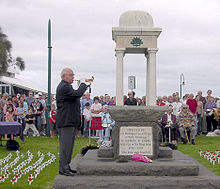
The Last Post is played at an ANZAC Day ceremony in Port Melbourne, Victoria. Similar ceremonies are held in most suburbs and towns.
Britain's Statute of Westminster 1931 formally ended most of the constitutional links between Australia and the UK. Australia adopted it in 1942,[68] but it was backdated to 1939 to confirm the validity of legislation passed by the Australian Parliament during World War II.[69][70] The shock of the UK's defeat in Asia in 1942 and the threat of Japanese invasion caused Australia to turn to the United States as a new ally and protector.[71] Since 1951, Australia has been a formal military ally of the US, under the ANZUS treaty.[72] After World War II Australia encouraged immigration from Europe. Since the 1970s and following the abolition of the White Australia policy, immigration from Asia and elsewhere was also promoted.[73] As a result, Australia's demography, culture, and self-image were transformed.[74] The final constitutional ties between Australia and the UK were severed with the passing of the Australia Act 1986, ending any British role in the government of the Australian States, and closing the option of judicial appeals to the Privy Council in London.[75] In a 1999 referendum, 55% of Australian voters and a majority in every Australian state rejected a proposal to become a republic with a president appointed by a two-thirds vote in both Houses of the Australian Parliament. Since the election of the Whitlam Government in 1972,[76] there has been an increasing focus in foreign policy on ties with other Pacific Rim nations, while maintaining close ties with Australia's traditional allies and trading partners.[77]
Politics
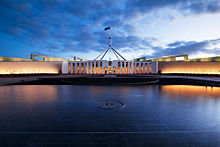
Parliament House, Canberra was opened in 1988, replacing the provisional Parliament House building opened in 1927.
The federal government is separated into three branches:
- The legislature: the bicameral Parliament, comprising the Queen (represented by the Governor-General), the Senate, and the House of Representatives;
- The executive: the Federal Executive Council, in practice the Governor-General as advised by the Prime Minister and Ministers of State;[81]
- The judiciary: the High Court of Australia and other federal courts, whose judges are appointed by the Governor-General on advice of the Council.
Australia's electoral system uses preferential voting for all lower house elections with the exception of Tasmania and the ACT, which, along with the Senate and most state upper houses, combine it with proportional representation in a system known as the single transferable vote. Voting is compulsory for all enrolled citizens 18 years and over in every jurisdiction,[85] as is enrolment (with the exception of South Australia).[86] Although the Prime Minister is appointed by the Governor-General, in practice the party with majority support in the House of Representatives forms government and its leader becomes Prime Minister.[citation needed]
There are two major political groups that usually form government, federally and in the states: the Australian Labor Party, and the Coalition which is a formal grouping of the Liberal Party and its minor partner, the National Party.[87][88] Independent members and several minor parties—including the Greens and the Australian Democrats—have achieved representation in Australian parliaments, mostly in upper houses.
Following a partyroom leadership challenge, Julia Gillard became the first female Prime Minister in June 2010.[89] The last federal election was held on 21 August 2010 and resulted in the first hung parliament in over 50 years. Gillard was able to form a minority Labor government with the support of independents.
States and territories
Main article: States and territories of Australia
Australia has six states—New South Wales, Queensland, South Australia, Tasmania, Victoria, and Western Australia—and two major mainland territories—the Northern Territory and the Australian Capital Territory (ACT). In most respects these two territories function as states, but the Commonwealth Parliament can override any legislation of their parliaments. By contrast, federal legislation overrides state legislation only in areas that are set out in Section 51 of the Australian Constitution; state parliaments retain all residual legislative powers, including those over schools, state police, the state judiciary, roads, public transport, and local government, since these do not fall under the provisions listed in Section 51.[90]Each state and major mainland territory has its own parliament—unicameral in the Northern Territory, the ACT, and Queensland, and bicameral in the other states. The states are sovereign entities, although subject to certain powers of the Commonwealth as defined by the Constitution. The lower houses are known as the Legislative Assembly (the House of Assembly in South Australia and Tasmania); the upper houses are known as the Legislative Council. The head of the government in each state is the Premier, and in each territory the Chief Minister. The Queen is represented in each state by a Governor; and in the Northern Territory, the Administrator.[91] In the Commonwealth, the Queen's representative is the Governor-General.[92]
The federal parliament directly administers the following territories:[81]
- Jervis Bay Territory, a naval base and sea port for the national capital in land that was formerly part of New South Wales
- Christmas Island and Cocos (Keeling) Islands
- Ashmore and Cartier Islands
- Coral Sea Islands
- Heard Island and McDonald Islands
- Australian Antarctic Territory
Foreign relations and military
Main articles: Foreign relations of Australia and Australian Defence Force

Australian Army soldiers conducting a foot patrol during a joint training exercise with US forces in Shoalwater Bay (2007).
Australia has pursued the cause of international trade liberalisation.[95][96][97] It led the formation of the Cairns Group and Asia-Pacific Economic Cooperation.[98][99] Australia is a member of the Organisation for Economic Co-operation and Development and the World Trade Organization,[100][101] and has pursued several major bilateral free trade agreements, most recently the Australia – United States Free Trade Agreement[102] and Closer Economic Relations with New Zealand,[103] with another free trade agreement being negotiated with Japan,[104] and South Korea in 2011.[105][106]
Along with New Zealand, the United Kingdom, Malaysia, and Singapore, Australia is party to the Five Power Defence Arrangements, a regional defence agreement. A founding member country of the United Nations, Australia is strongly committed to multilateralism,[107] and maintains an international aid program under which some 60 countries receive assistance. The 2005–06 budget provides A$2.5 billion for development assistance;[108] as a percentage of GDP, this contribution is less than that recommended in the UN Millennium Development Goals. Australia ranks seventh overall in the Center for Global Development's 2008 Commitment to Development Index.[109]
Australia's armed forces—the Australian Defence Force (ADF)—comprise the Royal Australian Navy (RAN), the Australian Army, and the Royal Australian Air Force (RAAF), in total numbering 80,561 personnel (including 55,068 regulars and 25,493 reservists).[110] The titular role of Commander-in-Chief is vested in the Governor-General, who appoints a Chief of the Defence Force from one of the armed services on the advice of the government.[111] Day-to-day force operations are under the command of the Chief, while broader administration and the formulation of defence policy is undertaken by the Minister and Department of Defence.
In the 2010–11 budget, defence spending was A$25.7 billion,[112] representing the 14th largest defence budget in the world but accounting for only 1.2% of global military spending.[113] Australia has been involved in UN and regional peacekeeping, disaster relief, and armed conflict; it currently has deployed approximately 3,330 defence force personnel in varying capacities to 12 overseas operations in areas including East Timor, Solomon Islands and Afghanistan.[114]
Geography and climate
The Great Barrier Reef, the world's largest coral reef,[122] lies a short distance off the north-east coast and extends for over 2,000 kilometres (1,240 mi). Mount Augustus, claimed to be the world's largest monolith,[123] is located in Western Australia. At 2,228 metres (7,310 ft), Mount Kosciuszko on the Great Dividing Range is the highest mountain on the Australian mainland, although Mawson Peak on the remote Australian territory of Heard Island is taller at 2,745 metres (9,006 ft).[124]
Australia is the flattest continent,[125] with the oldest and least fertile soils;[126][127] desert or semi-arid land commonly known as the outback makes up by far the largest portion of land. The driest inhabited continent, only its south-east and south-west corners have a temperate climate.[128] The population density, 2.8 inhabitants per square kilometre, is among the lowest in the world,[129] although a large proportion of the population lives along the temperate south-eastern coastline.[130]
Eastern Australia is marked by the Great Dividing Range that runs parallel to the coast of Queensland, New South Wales and much of Victoria – although the name is not strictly accurate, as in parts the range consists of low hills and the highlands are typically no more than 1,600 metres (5,249 ft) in height.[131] The coastal uplands and a belt of Brigalow grasslands lie between the coast and the mountains while inland of the dividing range are large areas of grassland.[131][132] These include the western plains of New South Wales and the Einasleigh Uplands, Barkly Tableland and the Mulga Lands of inland Queensland. The northern point of the east coast is the tropical rainforested Cape York Peninsula.[133][134][135][136]
The landscapes of the northern part of the country, the Top End and the Gulf Country behind the Gulf of Carpentaria, with their tropical climate, consist of woodland, grassland and desert.[137][138][139] At the northwest corner of the continent is the sandstone cliffs and gorges of The Kimberley and below that the Pilbara while south and inland of these lie more areas of grassland, the Ord Victoria Plain and the Western Australian Mulga shrublands.[140][141][142] The heart of the country is the uplands of central Australia while prominent features of the centre and south include the inland Simpson, Tirari and Sturt Stony, Gibson, Great Sandy, Tanami and Great Victoria Deserts with the famous Nullarbor Plain on the southern coast.[143][144][145][146]
The climate of Australia is significantly influenced by ocean currents, including the Indian Ocean Dipole and the El Niño-Southern Oscillation, which is correlated with periodic drought, and the seasonal tropical low pressure system that produces cyclones in northern Australia.[147][148] These factors induce rainfall to vary markedly from year to year. Much of the northern part of the country has a tropical predominantly summer rainfall (monsoon) climate.[149] Just under three quarters of Australia lies within a desert or semi-arid zone.[150] The southwest corner of the country has a Mediterranean climate.[151] Much of the southeast (including Tasmania) is temperate.[149]
Environment
Main article: Environment of Australia
Australian forests are mostly made up of evergreen species, particularly eucalyptus trees in the less arid regions, Wattles replace them in drier regions and deserts as the most dominant species.[154] Among well-known Australian fauna are the monotremes (the platypus and echidna); a host of marsupials, including the kangaroo, koala, and wombat, and birds such as the emu and the kookaburra.[154] Australia is home to many dangerous animals including some of the most venomous snakes in the world.[155] The dingo was introduced by Austronesian people who traded with Indigenous Australians around 3000 BCE.[156] Many plant and animal species became extinct soon after first human settlement,[157] including the Australian megafauna; others have disappeared since European settlement, among them the thylacine.[158][159]
Many of Australia's ecoregions, and the species within those regions, are threatened by human activities and introduced plant and animal species.[160] The federal Environment Protection and Biodiversity Conservation Act 1999 is the legal framework for the protection of threatened species.[161] Numerous protected areas have been created under the National Strategy for the Conservation of Australia's Biological Diversity to protect and preserve unique ecosystems;[162][163] 65 wetlands are listed under the Ramsar Convention,[164] and 15 natural World Heritage Sites have been established.[165] Australia was ranked 51th of 163 countries in the world on the 2010 Environmental Performance Index.[166]
Climate change has become an increasing concern in Australia in recent years,[167] with many Australians considering protection of the environment to be the most important issue facing the country.[168] The Rudd Ministry has initiated several emission reduction activities;[169] Rudd's first official act, on his first day in office, was to sign the instrument of ratification of the Kyoto Protocol. Nevertheless, Australia's carbon dioxide emissions per capita are among the highest in the world, lower than those of only a few other industrialised nations.[170] Rainfall in Australia has slightly increased over the past century, both nationwide and for two quadrants of the nation,[171] while annual mean temperatures increased significantly over the past decades.[172] Water restrictions are currently in place in many regions and cities of Australia in response to chronic shortages due to urban population increases and localised drought.[173]
Economy
Main article: Economy of Australia
Ranked third in the Index of Economic Freedom (2010),[176] Australia is the world's thirteenth largest economy and has the ninth highest per capita GDP; higher than that of the United Kingdom, Germany, France, Canada, Japan, and the United States. The country was ranked second in the United Nations 2010 Human Development Index and first in Legatum's 2008 Prosperity Index.[9] All of Australia's major cities fare well in global comparative liveability surveys;[177] Melbourne reached second place on The Economist's 2008 World's Most Livable Cities list, followed by Perth, Adelaide, and Sydney in fourth, seventh and ninth place respectively.[178] Total government debt in Australia is about $190 billion.[179] Australia has amongst the highest house prices and some of the highest household debt levels in the world.[180]
The Hawke Government floated the Australian dollar in 1983 and partially deregulated the financial system.[187] The Howard Government followed with a partial deregulation of the labour market and the further privatisation of state-owned businesses, most notably in the telecommunications industry.[188] The indirect tax system was substantially changed in July 2000 with the introduction of a 10% Goods and Services Tax (GST).[189] In Australia's tax system, personal and company income tax are the main sources of government revenue.[190]
In January 2007, there were 10,033,480 people employed, with an unemployment rate of 5.1%.[191] Youth unemployment (15-24) rose from 8.7% to 9.7% over 2008-2009.[192] Over the past decade, inflation has typically been 2–3% and the base interest rate 5–6%. The service sector of the economy, including tourism, education, and financial services, accounts for about 70% of GDP.[193] Although agriculture and natural resources account for only 3% and 5% of GDP respectively, they contribute substantially to export performance. Australia's largest export markets are Japan, China, the US, South Korea, and New Zealand.[194] Australia is the world's fourth largest exporter of wine, in an industry contributing $5.5 billion per annum to the nation's economy.[195]
Demography
Main articles: Demographics of Australia and Immigration to Australia
| Historic population[196] | ||
|---|---|---|
| Year | Indigenous population | |
| pre 1788 | 350,000 approximate | |
| Year | Non Indigenous population | Increase |
| 1788 | 900 | — |
| 1800 | 5,200 | 477.8% |
| 1850 | 405,400 | 7,696.2% |
| Year | Total population | Increase |
| 1900 | 3,765,300 | — |
| 1910 | 4,525,100 | 20.2% |
| 1920 | 5,411,000 | 19.6% |
| 1930 | 6,501,000 | 20.1% |
| 1940 | 7,078,000 | 8.9% |
| 1950 | 8,307,000 | 17.4% |
| 1960 | 10,392,000 | 25.1% |
| 1970 | 12,663,000 | 21.9% |
| 1980 | 14,726,000 | 16.3% |
| 1990 | 17,169,000 | 16.6% |
| 2000 | 19,169,100 | 11.6% |
| 2009 | 21,828,704 | 13.6% |
Australia's population has quadrupled since the end of World War I,[199] spurred by an ambitious immigration program. Following World War II and through to 2000, almost 5.9 million of the total population settled in the country as new immigrants, meaning that nearly two out of every seven Australians were born overseas.[200] Most immigrants are skilled,[201] but the immigration quota includes categories for family members and refugees.[201] The Federal Government estimates that cutting immigration from 280,000 to its target of 180,000 will result in a population of 36 million by 2050.[202]
In 2001, 23.1% of Australians were born overseas; the five largest immigrant groups were those from the United Kingdom, New Zealand, Italy, Vietnam, and China.[194][203] Following the abolition of the White Australia policy in 1973, numerous government initiatives have been established to encourage and promote racial harmony based on a policy of multiculturalism.[204] In 2005–06, more than 131,000 people emigrated to Australia, mainly from Asia and Oceania.[205] The migration target for 2006–07 was 144,000.[201][206] The total immigration quota for 2008–09 is around 300,000—its highest level since the Immigration Department was created after World War II.[207]
The Indigenous population—mainland Aborigines and Torres Strait Islanders—was counted at 410,003 (2.2% of the total population) in 2001, a significant increase from 115,953 in the 1976 census.[208] A large number of Indigenous people are not identified in the Census due to undercount and cases where their Indigenous status is not recorded on the form; after adjusting for these factors, the ABS estimated the true figure for 2001 to be around 460,140 (2.4% of the total population).[209]
Indigenous Australians experience higher than average rates of imprisonment and unemployment, lower levels of education, and life expectancies for males and females that are 11–17 years lower than those of non-indigenous Australians.[194][210][211] Some remote Indigenous communities have been described as having "failed state"-like conditions.[212][213][214][215][216]
In common with many other developed countries, Australia is experiencing a demographic shift towards an older population, with more retirees and fewer people of working age. In 2004, the average age of the civilian population was 38.8 years.[217] A large number of Australians (759,849 for the period 2002–03)[218] live outside their home country.
| Largest populated areas in Australia (June 2009 Australian Bureau of Statistics estimate)[219] | |||||||||||
|---|---|---|---|---|---|---|---|---|---|---|---|
| Rank | City Name | State | Pop. | Rank | City Name | State | Pop. |  Sydney  Melbourne | |||
| 1 | Sydney | NSW | 4,504,469 | 11 | Hobart | TAS | 212,019 | ||||
| 2 | Melbourne | VIC | 3,995,537 | 12 | Geelong | VIC | 175,803 | ||||
| 3 | Brisbane | QLD | 2,004,262 | 13 | Townsville | QLD | 168,402 | ||||
| 4 | Perth | WA | 1,658,992 | 14 | Cairns | QLD | 147,118 | ||||
| 5 | Adelaide | SA | 1,187,466 | 15 | Toowoomba | QLD | 128,600 | ||||
| 6 | Gold Coast-Tweed | QLD / NSW | 577,977 | 16 | Darwin | NT | 124,760 | ||||
| 7 | Newcastle | NSW | 540,796 | 17 | Launceston | TAS | 105,445 | ||||
| 8 | Canberra-Queanbeyan | ACT / NSW | 403,118 | 18 | Albury-Wodonga | NSW / VIC | 104,609 | ||||
| 9 | Wollongong | NSW | 288,984 | 19 | Ballarat | VIC | 94,088 | ||||
| 10 | Sunshine Coast | QLD | 245,309 | 20 | Bendigo | VIC | 89,995 | ||||
Language
Main article: Australian English

Nearly three quarters of Australians live in metropolitan cities and coastal areas. The beach is an integral part of the Australian identity.[220]
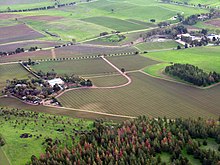
The Barossa Valley is a wine-producing region in South Australia. Fewer than 15% of Australians live in rural areas.
Between 200 and 300 Indigenous Australian languages are thought to have existed at the time of first European contact, of which only about 70 have survived. Many of these are exclusively spoken by older people; only 18 Indigenous languages are still spoken by all age groups.[224] At the time of the 2006 Census, 52,000 Indigenous Australians, representing 12% of the Indigenous population, reported that they spoke an Indigenous language at home.[225] Australia has a sign language known as Auslan, which is the main language of about 5,500 deaf people.[226]
Religion
Main article: Religion in Australia
Australia has no state religion. In the 2006 census, 64% of Australians listed themselves as Christian, including 26% as Roman Catholic and 19% as Anglican. About 19% of the population cited "No religion" (which includes humanism, atheism, agnosticism, and rationalism), which was the fastest-growing group from 2001 to 2006, and a further 12% did not answer (the question is optional) or did not give a response adequate for interpretation. The largest non-Christian religion in Australia is Buddhism (2.1%), followed by Islam (1.7%), Hinduism (0.8%), and Judaism (0.5%). Overall, fewer than 6% of Australians identify with non-Christian religions.[227] Weekly attendance at church services in 2004 was about 1.5 million: about 7.5% of the population.[228]Religion does not play a central role in the lives of much of the population.[229]
Education
Main article: Education in Australia
Main article: Tertiary education fees in Australia
School attendance is compulsory throughout Australia. All children receive 11 years of compulsory education from the age of 6 to 16 (Year 1 to 10),[230] before they can undertake two more years (Years 11 and 12), contributing to an adult literacy rate that is assumed to be 99%. A preparatory year prior to Year 1, although not compulsory, is almost universally undertaken.[230] In the Programme for International Student Assessment, Australia regularly scores among the top five of thirty major developed countries (member countries of the Organisation for Economic Co-operation and Development). Government grants have supported the establishment of Australia's 38 universities; all but one is public.[citation needed] OECD places Australia as among the most expensive nations to attend university.[231] There is a state-based system of vocational training, known as TAFE Institutes, and many trades conduct apprenticeships for training new tradespeople.[232] Approximately 58% of Australians aged from 25 to 64 have vocational or tertiary qualifications,[194] and the tertiary graduation rate of 49% is the highest among OECD countries. The ratio of international to local students in tertiary education in Australia is the highest in the OECD countries.[233]Health
Main article: Health care in Australia
Life expectancy in Australia is relatively high, with figures of 78.7 years for males and 83.5 years for females born in 2006.[234] Australia has the highest rates of skin cancer in the world,[235] while cigarette smoking is the largest preventable cause of death and disease.[236] Australia has one of the highest proportions of overweight citizens amongst developed nations;[237] it has also been one of the most successful in managing the spread of HIV/AIDS.[238][239]Australia introduced universal health care, known as Medibank, in 1975.[240] Reworked by successive governments, its current incarnation, Medicare came into existence in 1984. It is now nominally funded by an income tax surcharge known as the Medicare levy, currently set at 1.5%.[241] Traditionally, the management of public health has been split between the state and federal governments. The states manage hospitals and attached outpatient services, while the commonwealth funds the Pharmaceutical Benefits Scheme (reducing the costs of medicines) and general practice.[240] Under the Rudd government, a health reform plan has emerged which will allow the federal government to take "full responsibility for primary health care", essentially taking control of hospitals and outpatient services from the states.[242][243][244] Total expenditure on health (including private sector spending) is around 9.8 per cent of GDP.[245]
Culture
Main article: Culture of Australia
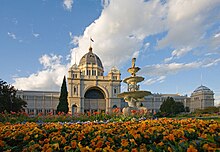
The Royal Exhibition Building in Melbourne was the first building in Australia to be listed as a UNESCO World Heritage Site in 2004[246]
Art
Main article: Visual arts of Australia
The country's landscape remains a source of inspiration for Australian modernist artists; it has been depicted in acclaimed works by the likes of Sidney Nolan,[256] Fred Williams,[257] Sydney Long,[258] and Clifton Pugh.[259] Australian artists influenced by modern American and European art include cubist Grace Crowley,[260] surrealist James Gleeson,[261] abstract expressionist Brett Whiteley,[262] and pop artist Martin Sharp.[263] Contemporary Indigenous Australian art is the only art movement of international significance to emerge from Australia[264][265] and "the last great art movement of the 20th century";[266] its exponents have included Emily Kngwarreye.[267][268] Art critic Robert Hughes has written several influential books about Australian history and art, and was described as the "world's most famous art critic" by The New York Times.[269] The National Gallery of Australia and state galleries maintain Australian and overseas collections.[270]
Performing arts
Main articles: Theatre of Australia and Dance in Australia
Many of Australia's performing arts companies receive funding through the federal government's Australia Council.[271] There is a symphony orchestra in each state,[272] and a national opera company, Opera Australia,[273] well-known for its famous soprano Joan Sutherland.[274] At the start of the 20th century, Nellie Melba was one of the world's leading opera singers.[275] Ballet and dance are represented by The Australian Ballet and various state companies. Each state has a publicly funded theatre company.[276][277][278]Media
Main articles: Television in Australia, Cinema of Australia, Media of Australia, Australian literature, and Music of Australia
The Australian cinema industry began with the 1906 release of The Story of the Kelly Gang, which is regarded as being the world's first feature-length film,[279] but both Australian feature film production and the distribution of British-made features declined dramatically after World War I as American studios and distributors monopolised the industry[280] and by the 1930s around 95% of the feature films screened in Australia were produced in Hollywood. By the late 1950s feature film production in Australia had effectively ceased and there were no all-Australian feature films made in the decade between 1959 and 1969.[281]Thanks to initiatives by the Gorton and Whitlam federal governments, the New Wave of Australian cinema of the 1970s brought provocative and successful films, some exploring the nation's colonial past, such as Picnic at Hanging Rock and Breaker Morant,[282] while the so-called "Ocker" genre produced several highly successful urban-based comedy features including The Adventures of Barry McKenzie and Alvin Purple.[283][284][285] Later hits included Mad Max and Gallipoli.[286][287] More recent successes included Shine and Rabbit-Proof Fence.[288][289] Notable Australian actors include Judith Anderson,[290] Errol Flynn,[291] Nicole Kidman, Hugh Jackman, Heath Ledger, Geoffrey Rush and current joint director of the Sydney Theatre Company, Cate Blanchett.[292][293]
Australian literature has also been influenced by the landscape; the works of writers such as Banjo Paterson, Henry Lawson, and Dorothea Mackellar captured the experience of the Australian bush.[294] The character of the nation's colonial past, as represented in early literature, is popular with modern Australians.[249] In 1973, Patrick White was awarded the Nobel Prize in Literature,[295] the first Australian to have achieved this.[296] Australian winners of the Man Booker Prize have included Peter Carey and Thomas Keneally;[297] David Williamson, and David Malouf are also renowned writers,[298] and Les Murray is regarded as "one of the leading poets of his generation".[299]
Australia has two public broadcasters (the Australian Broadcasting Corporation and the multicultural Special Broadcasting Service), three commercial television networks, several pay-TV services,[300] and numerous public, non-profit television and radio stations. Each major city has at least one daily newspaper,[300] and there are two national daily newspapers, The Australian and The Australian Financial Review.[300] In 2010, Reporters Without Borders placed Australia 18th on a list of 178 countries ranked by press freedom, behind New Zealand (8th) but ahead of the United Kingdom (19th) and United States (20th).[301] This relatively low ranking is primarily because of the limited diversity of commercial media ownership in Australia;[302] most print media are under the control of News Corporation and Fairfax Media.[303]
Cuisine
Main article: Australian cuisine
The food of Indigenous Australians was largely influenced by the area in which they lived. Most tribal groups subsisted on a simple hunter-gatherer diet, hunting native game and fish and collecting native plants and fruit. The general term for native Australian flora and fauna used as a source of food is bush tucker.[304][305] The first settlers introduced British food to the continent[306] which much of what is now considered typical Australian food is based on the Sunday roast has become an enduring tradition for many Australians.[307] Since the beginning of the 20th century, food in Australia has increasingly been influenced by immigrants to the nation, particularly from Southern European and Asian cultures.[306][307] Australian wine is produced in 60 distinct production areas totaling approximately 160,000 hectares, mainly in the southern, cooler parts of the country. The wine regions in each of these states produce different wine varieties and styles that take advantage of local climates and soil types. The predominant varieties are Shiraz, Cabernet Sauvignon, Chardonnay, Merlot, Sémillon, Pinot noir, Riesling, and Sauvignon blanc.[308][309][310][195][311][312] In 1995, an Australian red wine, Penfolds Grange, won the Wine Spectator award for Wine of the Year, the first time a wine from outside France or California achieved this distinction.[313]Sport
Main article: Sport in Australia
Around 24% Australians over the age of 15 regularly participate in organised sporting activities in Australia.[194] Australia has strong international teams in cricket, field hockey, netball, rugby league and rugby union, having been Olympic or world champions at least twice in each sport in the last 25 years for both men and women where applicable.[315][316][317][318][319][320][321][322] Australia is also powerful in track cycling, rowing, and swimming, having consistently been in the top-five medal-winners at Olympic or World Championship level since 2000.[323][324][325] Swimming is the strongest of these sports; Australia is the second-most prolific medal winner in the sport in Olympic history.[326][327][328]Some of Australia's most internationally well-known and successful sportspeople are swimmers Dawn Fraser, Murray Rose, Shane Gould and Ian Thorpe; sprinters Shirley Strickland, Betty Cuthbert and Cathy Freeman;[329] tennis players Rod Laver, Roy Emerson, Ken Rosewall, Evonne Goolagong, and Margaret Court; cricketers Donald Bradman and Shane Warne; three-time Formula One world champion Jack Brabham; five-time motorcycle grand prix world champion Mick Doohan; golfers Greg Norman and Karrie Webb;[330] cyclist Hubert Opperman; and prodigious billiards player Walter Lindrum.[331] Nationally, other popular sports include Australian rules football, horse racing, squash, surfing, soccer, and motor racing.
Australia has participated in every summer Olympics of the modern era,[332] and every Commonwealth Games.[333] Australia hosted the 1956 Summer Olympics in Melbourne and the 2000 Summer Olympics in Sydney,[334] and has ranked among the top six medal-takers since 2000.[335] Australia has also hosted the 1938, 1962, 1982, and 2006 Commonwealth Games.[336] Other major international events held in Australia include the Australian Open tennis grand slam tournament, international cricket matches, and the Australian Formula One Grand Prix. The highest-rating television programs include sports telecasts such as the summer Olympics, FIFA World Cup, State of Origin, and the grand finals of the National Rugby League and Australian Football League.[337]
See also(copy from wikipedia)
Main articles: Outline of Australia and Index of Australia-related articles





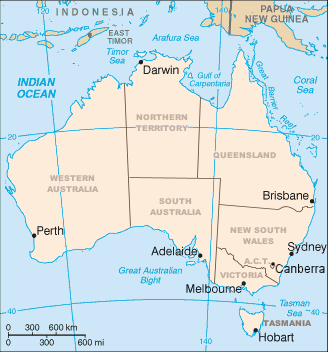


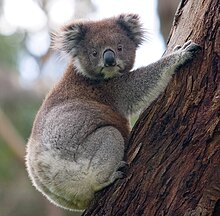


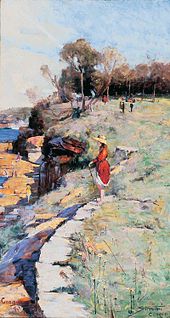


No comments:
Post a Comment